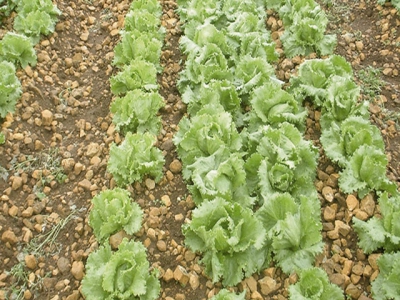Preparing to plant lettuce

The trend nowadays is to feed the soil and not the crop.
The row of lettuces on the left is too light, and yield is compromised. Photo: Bill Kerr
This helps to avoid imbalances and over-fertilising, which is wasteful and may result in lower yield and other problems.
The first step is to carry out a soil analysis and then add the elements that are lacking; this helps to create a balance in the soil. Thereafter, add nitrogen according to the crop’s requirements; this will vary considerably from crop to crop and depend on climatic conditions as well as factors such as leaching.
Equally important is soil pH, which must be adjusted to a level that suits the crop. Lettuce prefers a slightly acidic soil, but will also perform well at a pH of 8. In addition, lettuce likes organic matter, which reduces the risk of soil-borne diseases and makes growing it easier.
Beware of adding too much manure, though, as you could end up with an excess of available nitrogen. Along with the other stimulants in manure, this can, in the case of heading lettuce, cause the plants to produce an abundance of leaves at the cost of head size.
I once visited a farmer who had two adjoining lands. One had a fairly high organic content and was fertilised with a large quantity of chicken manure. The lettuce here was a dark green colour, lush and very vigorous – but produced small or no heads.
The lettuce in the adjoining land, which had received no manure, was a healthy but much lighter colour, and produced good-sized heads. The response of the lettuce to manure will also vary according to time of year and variety.
Requirements
The variety that you choose should be based on market requirements and climatic adaptability.
Market requirements
If you want to produce pre-packed lettuce, go for a variety that presents well when trimmed and wrapped. In contrast,
if you want to market unwrapped, loose heads in bulk boxes, select a variety with protective outer leaves.
Climatic adaptability
There are many varieties available today that are bolting-tolerant for summer production (heat and stress can cause bolting). Other varieties are cold- and disease-tolerant. As mentioned in a previous article, the heading types of lettuce are more vulnerable to cold when the heads become firm. In this case, it is usually the heading leaves that are scorched.
You can start off in the cold with young plants. This is relatively safe, provided the plants have not had too much nitrogen. This can cause tender growth, which can scorch when hit by a severe cold front. I saw this once where a farmer had applied nitrogen at a high rate, but missed a section of the crop. When a cold snap arrived, the entire land was severely damaged, apart from the section that had been skipped. This was easy to distinguish as it was a lighter colour.
Herbicides: a narrow choice
Few herbicides are suitable for lettuce. However, I have had success with Stomp, which I apply at 1l/ ha about 10 days before planting. I irrigate the land immediately afterwards. After about 10 days, when the weeds not killed by Stomp emerge, I apply 500ml to 1l/ ha Paraquat and plant immediately. Very few weeds survive.
Spacing
Lettuce should be spaced to accommodate light mechanical tillage. The spacing will vary according to the size required and the type of lettuce grown. For heading types, a good starting point is about 60 000 plants/ha. If you are not planting on beds, use closer spacing within the row and leave a gap between rows to accommodate a cultivating implement, if required.
As this is a transplanted crop, there is no need for fine land preparation and small clods are acceptable and often beneficial. The more we cultivate, the more we destroy the soil structure.
Related news
 Interesting facts about lettuce
Interesting facts about lettuce Lettuce has its origin in the eastern Mediterranean and has been cultivated for thousands of years. It is part of the daisy family Asteraceae
 How lettuce production has changed
How lettuce production has changed Back in the day, before cavity seedlings arrived on the scene, lettuce was directly sown, sometimes broadcast and usually planted in rows with a planter
 Garlic and broccoli: A delicious pairing that also repels pests
Garlic and broccoli: A delicious pairing that also repels pests For farmers and gardeners who want to skip conventional pesticides, options for fighting off pests can vary widely in effectiveness.